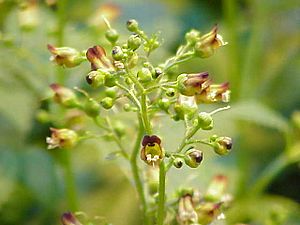Figwort family facts for kids
Quick facts for kids Figwort family |
|
|---|---|
 |
|
| Scrophularia nodosa | |
| Scientific classification | |
| Kingdom: | |
| (unranked): | |
| (unranked): | |
| (unranked): | |
| Order: | |
| Family: |
Scrophulariaceae
|
The Scrophulariaceae, also known as the figwort family, is a group of flowering plants. This plant family includes about 3,000 different types of plants, found in around 200 genera. Most of these plants grow in the cooler, northern parts of the world. The family gets its name from one of its main groups, the Scrophularia genus.
Contents
What are Figworts Like?
Plants in the figwort family are very diverse. They can be herbs, shrubs, or even small trees. Many of them have flowers that are shaped like tubes or bells. These flowers often have two "lips" and are quite colorful. They can be red, purple, yellow, or white.
Their leaves are usually arranged opposite each other on the stem. Some plants in this family have fuzzy leaves. The fruits are often capsules that split open to release many small seeds.
Where Do Figworts Grow?
You can find figworts all over the world. However, they are most common in the northern temperate regions. This means areas with moderate climates, like North America, Europe, and Asia. They grow in many different places, from dry, rocky areas to damp meadows. Some even grow in mountains.
Important Plants in the Figwort Family
Many plants from the figwort family are well-known. Some are grown in gardens for their beautiful flowers. Others are important in medicine.
- Mullein: Plants like great mullein (Verbascum thapsus) are tall and have soft, woolly leaves. They produce tall spikes of yellow flowers. Mullein has been used in traditional medicine for breathing problems.
- Snapdragons: Antirrhinum majus, or snapdragons, are popular garden flowers. Their flowers look like a dragon's mouth that opens and closes when squeezed. They come in many bright colors.
- Figworts: The Scrophularia genus itself includes plants often called figworts. They might not be as showy as snapdragons. But they are interesting plants, often found in damp places.
This family is a great example of how plants adapt to different environments. They show a wide range of shapes, sizes, and uses.
Images for kids
-
Texas Sage -- Leucophyllum frutescens
See also
 In Spanish: Scrophulariaceae para niños
In Spanish: Scrophulariaceae para niños



